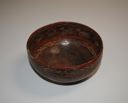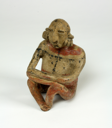Jalisco does not have an image.
100 BCE-250 CE
Mexican
Nomadic peoples moving south arrived in the Jalisco area around 15,000 years ago. Some of oldest evidence of human occupation is found around Zacoalco and Chapala lakes, which used to be connected. This evidence includes human and animal bones and tools made of bone and stone.Other signs of human habitation include petroglyphs and cave paintings found at Cabo Corrientes, San Gabriel, Jesús María, La Huerta, Puerto Vallarta, Mixtlán, Villa Purificación, Casimiro Castillo, Zapotlán el Grande and Pihuamo.
Agriculture began in the same region around 7,000 years ago, giving rise to the first permanent settlements in western Mexico.[42] Ceramics began to be produced about 3,500 years ago for both utilitarian and ceremonial purposes. The oldest pieces of Jalisco area pottery are called El Opeño, after an area near Zamora, Michoacán and Capacha after an area in Colima. The appearance of these styles indicates a certain specialization of labor, with distinct settled cultures established by 1000 BCE. The earliest settled cultures were centered on the site of Chupícuaro, Guanajuato, which has a large zone of influence from Durango east, crossing through modern Jalisco's north. Sites related to these cultures have been found in Bolaños, Totoate, the Bolaños River Canyon and Totatiche as well as other locations in the Los Altos Region. Cultures dating to the early part of the Christian era are distinguished by the use of shaft tombs, with major examples found in Acatlán de Juárez, El Arenal and Casimiro Castillo. The use of this type of tomb is unknown anywhere else in Mexico. In the 7th century, Toltec and Teotihuacan influence is evident in the area, with a dominion called Xalisco established by the Toltecs in 618.The dominion was established through the military domination of the weaker local groups. During this time, ceramics were improved and the working of gold, silver and copper appeared. More recent archeology of the area has produced evidence of larger cities, large scale irrigation and a kind of script used by various cultures of the area. The Toltec influence had a strong influence over religious development with deities formalizing into gods recognized by the later Aztec civilization such as Tlāloc, Mictlāntēcutli and Quetzalcoatl. A number of cities were built during this time, including Ixtepete, which show many features of Mesoamerican architecture such as the building of pyramid bases, temples and Mesoamerican ball courts. However, these are sparse because there were very few communities of the size needed to support them. Stones used for building were often cut in angles and with relief such as those found in Tamazula and El Chanal, Colima. Ixtepete from the tenth century has talud/tablero construction showing Teotihuacan influence. By 1112, the tribes dominated by the Toltecs rebelled and brought an end to the domination; however, the area would be conquered again in 1129, this time by the Chichimecas.
By 1325, the Purépecha had become dominant in parts of the state, but in 1510, the indigenous settlements of Zapotlán, Sayula and Zacoalco pushed back the Purépecha during the Salitre War.
One reason for ancient civilizations in the area was the large deposits of obsidian and it was the center of the Teuchitlán nation. Evidence of the most advanced pre Hispanic cultures are found in the center and south of the state. The most important site is Ixtepete in Zapopan which dates from between the 5th and 10th centuries and shows Teotihuacan influence. Other sites include Atitlán, El Mirador, El Reliz and Las Cuevas in San Juanito de Escobedo, Portezuelo in Ameca, Santa Cruz de Bárcenas in Ahualulco de Mercado, Santa Quitería, Huaxtla and Las Pilas in El Arenal, La Providencia, Laguna Colorada, Las Cuevas, El Arenal and Palacio de Oconahua in Etzatlán, Cerro de la Navaja, Huitzilipa and Xochitepec in Magdalena and the Ixtapa Ceremonial Center in Puerto Vallarta.
Source: Wikipedia
Bowl 1989.007
Male Figure with Drum 1986.058
Seated Female Figure 1986.041
Seated Female with Dog 1986.128
Seated Figure 1986.063
Seated Figure with Fan 1986.044
Standing Female Figure 1986.093
Standing Warrior with Spear 1986.062







